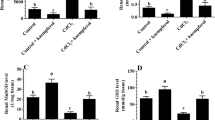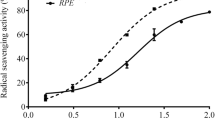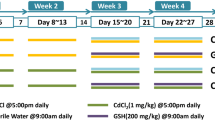Abstract
This study evaluated the protective effect of kaempferol, a natural flavonoid, against cadmium chloride (CdCl2)-induced liver damage and examined the possible anti-inflammatory and antioxidant mechanisms of protection. Adult male rats were divided into 4 groups (each of 8 rats) as control, kaempferol (50 mg/kg/day orally), CdCl2 (15 ppm/day), and CdCl2 (15 ppm/day) + kaempferol (50 mg/kg/day). All treatments were given for 30 days. With no effect on attenuating the reduced food intake, kaempferol significantly increased body weight and lowered serum levels of liver injury markers including bilirubin, alanine aminotransferase (ALT), aspartate aminotransferase (AST), and gamma-glutamyltransferase 1 (γ-GTT1) in the CdCl2-treated rats. It also restored normal liver architectures, prevented hepatocyte, loss, and swelling and reduced inflammatory cell infiltration. These effects were associated with a reduction in mitochondrial permeability transition pore, as well as in the expression of cytochrome-c and cleaved caspase-3, markers of mitochondrial damage, and intrinsic cell death. In both the control positive and CdCl2-treated rats, kaempferol significantly lowered the hepatic levels of reactive oxygen species, malondialdehyde (MDA), tumor necrosis factor-α (TNF-α), Interleukine-6 (IL-6), and the nuclear activity and localization of NF-κB p65. Besides, kaempferol significantly increased the hepatic total and nuclear levels of the nuclear factor erythroid 2–related factor 2 (Nrf2) and heme oxygenase-1, as well as levels of superoxide dismutase (SOD) and reduced glutathione (GSH) but reduced the cytoplasmic protein levels of keap1. In conclusion, the protective effect of kaempferol against CdCl2-induced hepatic damage is mediated by antioxidant and anti-inflammatory effects driven by upregulating Nrf2/HO-1 axis and suppressing the NF-κB p65 and keap1.







Similar content being viewed by others
Data availability
The data used to support the findings of this study are available from the corresponding author upon request.
References
Abarikwu SO, Njoku RC, Lawrence CJ, Charles IA, Ikewuchi JC (2017) Rutin ameliorates oxidative stress and preserves hepatic and renal functions following exposure to cadmium and ethanol. Pharm Biol 55:2161–2169. https://doi.org/10.1080/13880209.2017.1387575
Adhihetty PJ, Ljubicic V, Menzies KJ, Hood DA (2005) Differential susceptibility of subsarcolemmal and intermyofibrillar mitochondria to apoptotic stimuli. Am J Physiol Cell Physiol 289:C994–c1001. https://doi.org/10.1152/ajpcell.00031.2005
Ağır MS, Eraslan G (2019) The effect of diosmin against liver damage caused by cadmium in rats. J Food Biochem 43:e12966. https://doi.org/10.1111/jfbc.12966
Amara S, Abdelmelek H, Garrel C, Guiraud P, Douki T, Ravanat JL, Favier A, Sakly M, Ben Rhouma K (2008) Preventive effect of zinc against cadmium-induced oxidative stress in the rat testis. J Reprod Dev 54:129–134. https://doi.org/10.1262/jrd.18110
Arroyo V, Flores K, Ortiz L, Gómez-Quiroz L, Gutiérrez-Ruiz M (2012) Liver and cadmium toxicity. J Drug Metab Toxicol S 5
Belyaeva EA, Korotkov SM, Saris NE (2011) In vitro modulation of heavy metal-induced rat liver mitochondria dysfunction: a comparison of copper and mercury with cadmium. J Trace Elem Med Biol 25(Suppl 1):S63–S73. https://doi.org/10.1016/j.jtemb.2010.10.007
Bilgen I, Oner G, Edremitlioğlu M, Alkan Z, Cirrik S (2003) Involvement of cholinoceptors in cadmium-induced endothelial dysfunction. J Basic Clin Physiol Pharmacol 14:55–76. https://doi.org/10.1515/jbcpp.2003.14.1.55
Chang CJ, Tzeng TF, Liou SS, Chang YS, Liu IM (2011) Kaempferol regulates the lipid-profile in high-fat diet-fed rats through an increase in hepatic PPARα levels. Planta Med 77:1876–1882. https://doi.org/10.1055/s-0031-1279992
Chen HJ, Lin CM, Lee CY, Shih NC, Peng SF, Tsuzuki M, Amagaya S, Huang WW, Yang JS (2013) Kaempferol suppresses cell metastasis via inhibition of the ERK-p38-JNK and AP-1 signaling pathways in U-2 OS human osteosarcoma cells. Oncol Rep 30:925–932. https://doi.org/10.3892/or.2013.2490
Cui S, Tang J, Wang S, Li L (2019) Kaempferol protects lipopolysaccharide-induced inflammatory injury in human aortic endothelial cells (HAECs) by regulation of miR-203. Biomed Pharmacother 115:108888. https://doi.org/10.1016/j.biopha.2019.108888
Devi KP, Malar DS, Nabavi SF, Sureda A, Xiao J, Nabavi SM, Daglia M (2015) Kaempferol and inflammation: from chemistry to medicine. Pharmacol Res 99:1–10. https://doi.org/10.1016/j.phrs.2015.05.002
Diep PT, Denizeau F, Jumarie C (2005) Kinetics of the early subcellular distribution of cadmium in rat hepatocytes. Biometals 18:255–267. https://doi.org/10.1007/s10534-005-1538-3
Dong L, Yin L, Quan H, Chu Y, Lu J (2017) Hepatoprotective effects of kaempferol-3-O-α-l-arabinopyranosyl-7-O-α-l-rhamnopyranoside on d-galactosamine and lipopolysaccharide caused hepatic failure in mice. Molecules 22doi:10.3390/molecules22101755
El-kott AF, Abd-El-Karim M, Khalifa HS, Morsy K, Ibrahim EH, Bin-Jumah M, Abdel-Daim MM, Aleya L (2020a) Kaempferol protects against cadmium chloride-induced hippocampal damage and memory deficits by activation of silent information regulator 1 and inhibition of poly (ADP-Ribose) polymerase-1. Science of The Total Environment, 138832.
El-Kott AF, Bin-Meferij MM, Eleawa SM, Alshehri MM (2020b) Kaempferol protects against cadmium chloride-induced memory loss and hippocampal apoptosis by increased intracellular glutathione stores and activation of PTEN/AMPK induced inhibition of Akt/mTOR signaling. Neurochem Res 45:295–309. https://doi.org/10.1007/s11064-019-02911-4
Eybl V, Kotyzová D, Bludovská M (2004) The effect of curcumin on cadmium-induced oxidative damage and trace elements level in the liver of rats and mice. Toxicol Lett 151:79–85. https://doi.org/10.1016/j.toxlet.2004.02.019
Fischer AH, Jacobson KA, Rose J, Zeller R (2008) Hematoxylin and eosin staining of tissue and cell sections. CSH Protoc 2008, pdb.prot4986. doi:10.1101/pdb.prot4986
Gebhardt R (2009) Prevention of cadmium-induced toxicity in liver-derived cells by the combination preparation Hepeel(®). Environ Toxicol Pharmacol 27:402–409. https://doi.org/10.1016/j.etap.2009.01.006
Go YM, Sutliff RL, Chandler JD, Khalidur R, Kang BY, Anania FA, Orr M, Hao L, Fowler BA, Jones DP (2015) Low-dose cadmium causes metabolic and genetic dysregulation associated with fatty liver disease in mice. Toxicol Sci 147:524–534. https://doi.org/10.1093/toxsci/kfv149
Grosset AA, Loayza-Vega K, Adam-Granger É, Birlea M, Gilks B, Nguyen B, Soucy G, Tran-Thanh D, Albadine R, Trudel D (2019) Hematoxylin and eosin counterstaining protocol for immunohistochemistry interpretation and diagnosis. Appl Immunohistochem Mol Morphol 27:558–563. https://doi.org/10.1097/pai.0000000000000626
Haouem S, El Hani A (2013) Effect of cadmium on lipid peroxidation and on some antioxidants in the liver, kidneys and testes of rats given diet containing cadmium-polluted radish bulbs. J Toxicol Pathol 26:359–364. https://doi.org/10.1293/tox.2013-0025
Horiguchi H, Harada A, Oguma E, Sato M, Homma Y, Kayama F, Fukushima M, Matsushima K (2000) Cadmium-induced acute hepatic injury is exacerbated in human interleukin-8 transgenic mice. Toxicol Appl Pharmacol 163:231–239. https://doi.org/10.1006/taap.1999.8877
Hussein RM, Mohamed WR, Omar HA (2018) A neuroprotective role of kaempferol against chlorpyrifos-induced oxidative stress and memory deficits in rats via GSK3β-Nrf2 signaling pathway. Pestic Biochem Physiol 152:29–37. https://doi.org/10.1016/j.pestbp.2018.08.008
Hwang D, Wang L (2001) Effect of taurine on toxicity of cadmium in rats. Toxicology 167:173–180
Hyder O, Chung M, Cosgrove D, Herman JM, Li Z, Firoozmand A, Gurakar A, Koteish A, Pawlik TM (2013) Cadmium exposure and liver disease among US adults. J Gastrointest Surg 17:1265–1273. https://doi.org/10.1007/s11605-013-2210-9
Imran M, Rauf A, Shah ZA, Saeed F, Imran A, Arshad MU, Ahmad B, Bawazeer S, Atif M, Peters DG, Mubarak MS (2019) Chemo-preventive and therapeutic effect of the dietary flavonoid kaempferol: a comprehensive review. Phytother Res 33:263–275. https://doi.org/10.1002/ptr.6227
Kavazis AN, Morton AB, Hall SE, Smuder AJ (2017) Effects of doxorubicin on cardiac muscle subsarcolemmal and intermyofibrillar mitochondria. Mitochondrion 34:9–19. https://doi.org/10.1016/j.mito.2016.10.008
Kawagoe M, Hirasawa F, Cun Wang S, Liu Y, Ueno Y, Sugiyama T (2005) Orally administrated rare earth element cerium induces metallothionein synthesis and increases glutathione in the mouse liver. Life Sci 77:922–937. https://doi.org/10.1016/j.lfs.2005.02.004
Kim JK, Park SU (2020) Recent studies on kaempferol and its biological and pharmacological activities. Excli j 19:627–634
Koyu A, Gokcimen A, Ozguner F, Bayram DS, Kocak A (2006) Evaluation of the effects of cadmium on rat liver. Mol Cell Biochem 284:81–85. https://doi.org/10.1007/s11010-005-9017-2
Liu C, Zhu Y, Lu Z, Guo W, Tumen B, He Y, Chen C, Hu S, Xu K, Wang Y, Li L, Li S (2019) Cadmium induces acute liver injury by inhibiting Nrf2 and the role of NF-κB, NLRP3, and MAPKs signaling pathway. Int J Environ Res Public Health 17doi:10.3390/ijerph17010138
Luo JF, Shen XY, Lio CK, Dai Y, Cheng CS, Liu JX, Yao YD, Yu Y, Xie Y, Luo P, Yao XS, Liu ZQ, Zhou H (2018) Activation of Nrf2/HO-1 pathway by nardochinoid C inhibits inflammation and oxidative stress in lipopolysaccharide-stimulated macrophages. Front Pharmacol 9:911. https://doi.org/10.3389/fphar.2018.00911
Newairy AA, El-Sharaky AS, Badreldeen MM, Eweda SM, Sheweita SA (2007) The hepatoprotective effects of selenium against cadmium toxicity in rats. Toxicology 242:23–30. https://doi.org/10.1016/j.tox.2007.09.001
Nwokocha CR, Nwokocha MI, Owu DU, Obi J, Olatunde B, Ebe C, Nwangwu O, Iwuala MO (2012) Comparative analysis on the effect of palm oil (Elaeis guineensis) in reducing cadmium and lead accumulation in liver of Wistar rats. Pharmacognosy Res 4:214–218. https://doi.org/10.4103/0974-8490.102266
Pari L, Murugavel P (2005) Role of diallyl tetrasulfide in ameliorating the cadmium induced biochemical changes in rats. Environ Toxicol Pharmacol 20:493–500. https://doi.org/10.1016/j.etap.2005.05.009
Park SE, Sapkota K, Kim S, Kim H, Kim SJ (2011) Kaempferol acts through mitogen-activated protein kinases and protein kinase B/AKT to elicit protection in a model of neuroinflammation in BV2 microglial cells. Br J Pharmacol 164:1008–1025. https://doi.org/10.1111/j.1476-5381.2011.01389.x
Rana K, Verma Y, Rana SVS (2020) Possible mechanisms of liver injury induced by cadmium sulfide nanoparticles in rat. Biol Trace Elem Resdoi:10.1007/s12011-020-02128-5
Rani A, Kumar A, Lal A, Pant M (2014) Cellular mechanisms of cadmium-induced toxicity: a review. Int J Environ Health Res 24:378–399. https://doi.org/10.1080/09603123.2013.835032
Renugadevi J, Prabu SM (2010) Cadmium-induced hepatotoxicity in rats and the protective effect of naringenin. Exp Toxicol Pathol 62:171–181. https://doi.org/10.1016/j.etp.2009.03.010
Rikans LE, Yamano T (2000) Mechanisms of cadmium-mediated acute hepatotoxicity. J Biochem Mol Toxicol 14:110–117. https://doi.org/10.1002/(sici)1099-0461(2000)14:2<110::aid-jbt7>3.0.co;2-j
Rzepecka J, Pineda MA, Al-Riyami L, Rodgers DT, Huggan JK, Lumb FE, Khalaf AI, Meakin PJ, Corbet M, Ashford ML, Suckling CJ, Harnett MM, Harnett W (2015) Prophylactic and therapeutic treatment with a synthetic analogue of a parasitic worm product prevents experimental arthritis and inhibits IL-1β production via NRF2-mediated counter-regulation of the inflammasome. J Autoimmun 60:59–73. https://doi.org/10.1016/j.jaut.2015.04.005
Sanjeev S, Bidanchi RM, Murthy MK, Gurusubramanian G, Roy VK (2019) Influence of ferulic acid consumption in ameliorating the cadmium-induced liver and renal oxidative damage in rats. Environ Sci Pollut Res Int 26:20631–20653. https://doi.org/10.1007/s11356-019-05420-7
Saw CL, Guo Y, Yang AY, Paredes-Gonzalez X, Ramirez C, Pung D, Kong AN (2014) The berry constituents quercetin, kaempferol, and pterostilbene synergistically attenuate reactive oxygen species: involvement of the Nrf2-ARE signaling pathway. Food Chem Toxicol 72:303–311. https://doi.org/10.1016/j.fct.2014.07.038
Toppo R, Roy BK, Gora RH, Baxla SL, Kumar P (2015) Hepatoprotective activity of Moringa oleifera against cadmium toxicity in rats. Vet World 8, 537-40. doi:10.14202/vetworld.2015.537-540
Tsai MS, Wang YH, Lai YY, Tsou HK, Liou GG, Ko JL, Wang SH (2018) Kaempferol protects against propacetamol-induced acute liver injury through CYP2E1 inactivation, UGT1A1 activation, and attenuation of oxidative stress, inflammation and apoptosis in mice. Toxicol Lett 290:97–109. https://doi.org/10.1016/j.toxlet.2018.03.024
Wang H, Chen L, Zhang X, Xu L, Xie B, Shi H, Duan Z, Zhang H, Ren F (2019) Kaempferol protects mice from d-GalN/LPS-induced acute liver failure by regulating the ER stress-Grp78-CHOP signaling pathway. Biomed Pharmacother 111:468–475. https://doi.org/10.1016/j.biopha.2018.12.105
Wang M, Sun J, Jiang Z, Xie W, Zhang X (2015) Hepatoprotective effect of kaempferol against alcoholic liver injury in mice. Am J Chin Med 43:241–254. https://doi.org/10.1142/s0192415x15500160
Wang T, Wu Q, Zhao T (2020) Preventive effects of kaempferol on high-fat diet-induced obesity Complications in C57BL/6 Mice. Biomed Res Int 2020:4532482–4532489. https://doi.org/10.1155/2020/4532482
Wardyn JD, Ponsford AH, Sanderson CM (2015) Dissecting molecular cross-talk between Nrf2 and NF-κB response pathways. Biochem Soc Trans 43:621–626. https://doi.org/10.1042/bst20150014
Wu KC, Liu JJ, Klaassen CD (2012) Nrf2 activation prevents cadmium-induced acute liver injury. Toxicol Appl Pharmacol 263:14–20. https://doi.org/10.1016/j.taap.2012.05.017
Wu W, Yang B, Qiao Y, Zhou Q, He H, He M (2020) Kaempferol protects mitochondria and alleviates damages against endotheliotoxicity induced by doxorubicin. Biomed Pharmacother 126:110040. https://doi.org/10.1016/j.biopha.2020.110040
Xu T, Huang S, Huang Q, Ming Z, Wang M, Li R, Zhao Y (2019) Kaempferol attenuates liver fibrosis by inhibiting activin receptor-like kinase 5. J Cell Mol Med 23:6403–6410. https://doi.org/10.1111/jcmm.14528
Yamano T, DeCicco LA, Rikans LE (2000) Attenuation of cadmium-induced liver injury in senescent male fischer 344 rats: role of Kupffer cells and inflammatory cytokines. Toxicol Appl Pharmacol 162:68–75. https://doi.org/10.1006/taap.1999.8833
Yao H, Sun J, Wei J, Zhang X, Chen B, Lin Y (2020) Kaempferol protects blood vessels from damage induced by oxidative stress and inflammation in association with the Nrf2/HO-1 signaling pathway. Front Pharmacol 11:1118. https://doi.org/10.3389/fphar.2020.01118
Yazıhan N, Koçak MK, Akçıl E, Erdem O, Sayal A, Güven C, Akyürek N (2011) Involvement of galectin-3 in cadmium-induced cardiac toxicity. Anadolu Kardiyol Derg 11:479–484. https://doi.org/10.5152/akd.2011.130
Zang Y, Zhang D, Yu C, Jin C, Igarashi K (2017) Antioxidant and hepatoprotective activity of kaempferol 3-O-β-D-(2, 6-di-O-α-L-rhamnopyranosyl) galactopyronoside against carbon tetrachloride-induced liver injury in mice. Food science and biotechnology 26:1071–1076
Zhang L, Guo Z, Wang Y, Geng J, Han S (2019) The protective effect of kaempferol on heart via the regulation of Nrf2, NF-κβ, and PI3K/Akt/GSK-3β signaling pathways in isoproterenol-induced heart failure in diabetic rats. Drug Dev Res 80:294–309. https://doi.org/10.1002/ddr.21495
Zhang Y, Li JH, Liu XR, Jiang FL, Tian FF, Liu Y (2011) Spectroscopic and microscopic studies on the mechanisms of mitochondrial toxicity induced by different concentrations of cadmium. J Membr Biol 241:39–49. https://doi.org/10.1007/s00232-011-9361-y
Funding
This study was supported by the deanship of Scientific Research at King Khalid University, Abha, KSA under grant number (R.G.P1 /227/41). Also, this research was funded by the Taif University Researchers Supporting under grant number (TURSP-2020/99), Taif University, Taif, Saudi Arabia. Also, this research work was funded by the Deanship of Scientific Research at Princess Nourah bint Abdulrahman University, through the Fast-track Research Funding Program.
Author information
Authors and Affiliations
Contributions
Ali S. Alshehri: Conceptualization, Methodology, Validation, Formal analysis, Investigation, Supervision, Project administration, Funding acquisition, Writing—original draft. Mohamed S A. El-Gerbed and Heba S. Khalifa: Conceptualization, Validation, Formal analysis, Investigation, Writing—original draft. Ayman E. El-Kenawy and Attalla F. El-Kott: Conceptualization, Investigation, Methodology, Writing—review and editing. Ghadeer M. Albadrani: Investigation, Methodology, Writing—review and editing
Corresponding author
Ethics declarations
Ethics approval and consent to participate
All applicable international, national, and/or institutional guidelines for the care and use of animals and cell lines were followed and approved by the ethics committee at the King Khalid University (Ethical number ECM#2020-1701). All authors equally participate in the study.
Consent for publication
All authors allow the publication of the paper.
Conflict of interest
The authors declare no competing interests.
Additional information
Responsible Editor: Mohamed M. Abdel-Daim
Publisher’s note
Springer Nature remains neutral with regard to jurisdictional claims in published maps and institutional affiliations.
Rights and permissions
About this article
Cite this article
Alshehri, A.S., El-kott, A.F., El-Gerbed, M.S.A. et al. Kaempferol prevents cadmium chloride-induced liver damage by upregulating Nrf2 and suppressing NF-κB and keap1. Environ Sci Pollut Res 29, 13917–13929 (2022). https://doi.org/10.1007/s11356-021-16711-3
Received:
Accepted:
Published:
Issue Date:
DOI: https://doi.org/10.1007/s11356-021-16711-3




